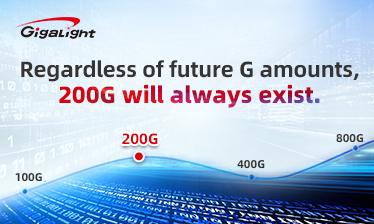With the rapid development of information technology, the demand for network bandwidth in data centers is like a wild horse running wild. From 10G to 100G, and then to the hotly debated 400G and even 800G, each leap in technology marks a new milestone in data transmission speed. However, in this speed competition, there is a firm and clear voice: “No matter how many Gs there are, there will be no 200G.” This is the firm proposition of Gigalight.

The trap of leaping: a direct jump from 100G to 400G?
Many opinions in the industry believe that with the rapid development of technology, it is possible to jump directly from 100G to 400G, skipping the intermediate stage of 200G. This view seems to conform to the trend of accelerated technological iteration, but in fact ignores the actual needs and cost-effectiveness considerations in the network upgrade process. The evolution of technology is not a simple digital superposition, but needs to take into account compatibility, stability and return on investment.
200G Optical Transceiver: An Indispensable Bridge
Gigalight is well aware that in the era of data torrents, 200G optical transceivers are not only the inevitable product of technological progress, but also the key bridge connecting the present and the future. It can not only meet the growing bandwidth needs of current data centers, but also provide a solid foundation for 400G and even higher-speed network upgrades in the future.
Cost-effectiveness: Compared with direct deployment of 400G, 200G optical transceivers are more cost-effective and provide a more flexible upgrade path for data center operators. Through gradual transition, initial investment can be effectively controlled while ensuring steady improvement of network performance.
Technical compatibility: The design of 200G optical transceivers fully considers the compatibility with the existing network architecture, making the upgrade process smoother, without the need for large-scale network reconstruction, and reducing the upgrade risk and complexity.
High cost performance: In terms of cost performance or in the long run, 200G data center is still the king. Its advantages of low power consumption and technical solutions are extremely obvious, especially for some underdeveloped countries or enterprise-level data centers, 200G should be the first choice for a long time.
Market demand: Although some people advocate a direct jump, the market demand is diversified. Many application scenarios have an urgent need for 200G bandwidth, which provides a broad market space for 200G optical modules.
Gigalight’s persistence: leading the 200G era
As a leader in open optical networks, Gigalight has always been at the forefront of technology and is committed to promoting the innovation and development of optical modules. We firmly believe that 200G optical modules are not only an inevitable stage in technological development, but also the key to meeting current and future market needs. Therefore, Gigalight has invested a lot of resources to develop a series of high-performance and high-reliability 200G optical module products, aiming to provide customers with the most optimized network upgrade solutions.
Gigalight is equipped with 200G products to cope with two 200G data center architectures:
200G 8×25G NRZ: As the existing network is mostly based on 25G NRZ and has a demand for low latency, the 200G architecture of 8×25G NRZ is suitable;
200G 4×50G PAM4: As there are no special performance requirements for new network construction, the total equipment cost can be reduced through PAM4 electrical chips, allowing PAM4 technology to be used, and the 200G architecture of 4×50G PAM4 is suitable.
The list of 200G Ethernet optical modules with two different architectures and their application scenarios are as follows:
200G (8×25G NRZ)
- 200G QSFP-DD SR8 (low latency, commonly used in the internal interconnection of the chassis, the interconnection between TOR switches and server network cards)
- 200G QSFP-DD PSM8 (low latency, interconnection between frames, and abundant single-mode fiber)
- 200G QSFP-DD LR8 (8-wave LAN-WDM, low dispersion long-distance transmission, suitable for DCI interconnection)
- 200G QSFP-DD 2×CWDM4 (low latency, interconnection between chassis, while significantly reducing the use of single-mode fiber)

200G (4×50G PAM4)
- 200G QSFP56 SR4 (commonly used in the interconnection within the chassis, the interconnection between TOR switches and server network cards)
- 200G QSFP56 DR4 (interconnection between frames, with abundant single-mode fiber)
- 200G QSFP56 FR4 (interconnection between frames while significantly reducing single-mode fiber usage)
- 200G QSFP56 LR4 (DCI interconnect, long distance transmission)

In addition, Gigalight also provides 200G QSFP-DD optical modules based on 4×50G PAM4, which can provide users with more diverse product choices to meet the specific needs of different users.

In the wave of technology, every step needs to be cautious and firm. Although the network speed in the future will continue to break records, Gigalight firmly believes that no matter how many Gs there are, 200G optical modules will be an indispensable part and play a unique and important role. Choose Gigalight and let us join hands in a new era of more efficient and intelligent data transmission.
